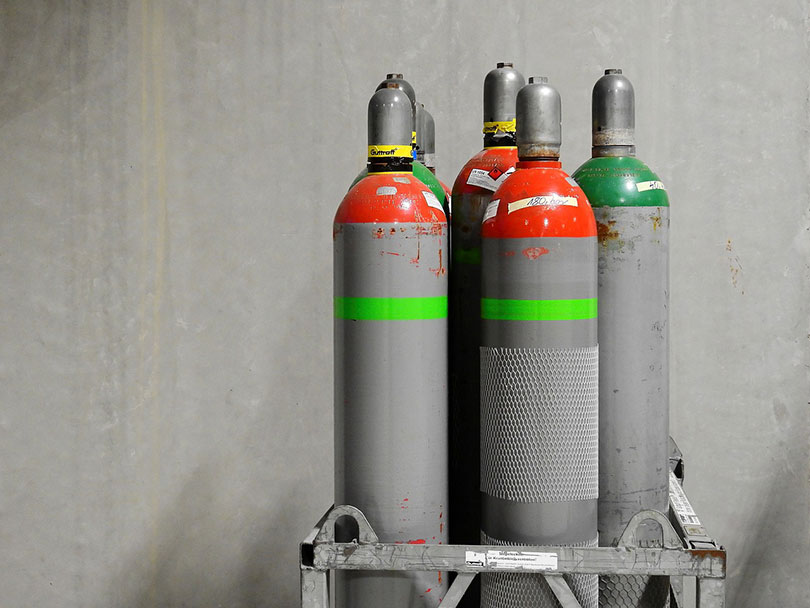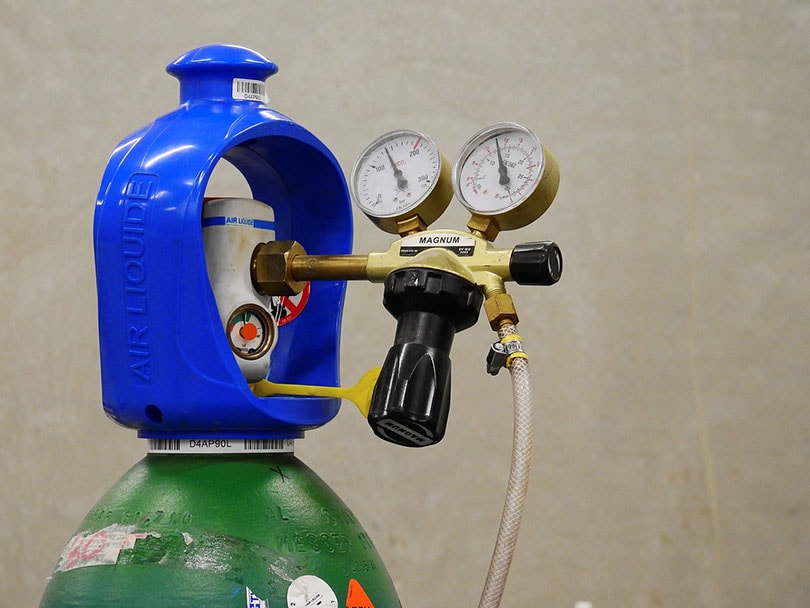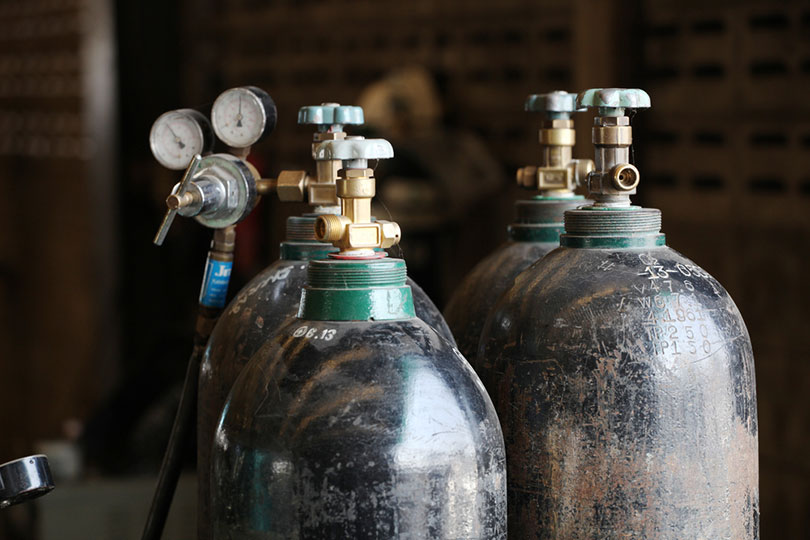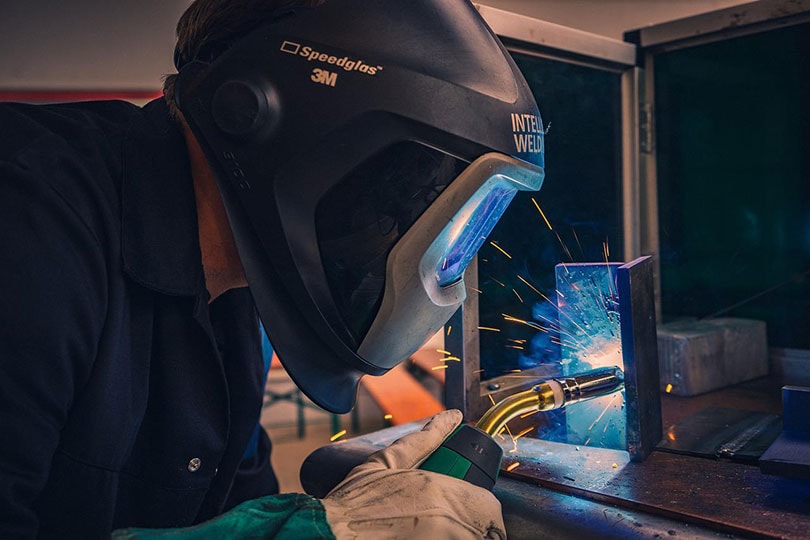What Should My MIG Welding Gas Pressure Be?
Last Updated on

MIG welding is a versatile welding method. MIG welding machines allow easier welding than shielded metal arc welding (SMAW). They use gas as filler instead of flux for the filler material.
Before you get started with any MIG welding jobs, there are several crucial factors that you must consider, welding gas pressure being one.
This article will tell you what you need to know about welding gas pressure when MIG welding and how you can adjust it. Read on to learn more!
Suitable MIG Welding Gas Pressure
MIG welding gas pressure is a crucial factor in the quality of your welds. Besides ensuring you’ve got the right tip for the job, it’s crucial to have a suitable gas pressure setting. This way, you’ll get the best possible weld.
Usually, you should set your MIG welding gas pressure based on what metal type you’re working with. If you’re creating a weld that is too weak or too strong, it can either cause your weld to crack or break apart.
Ensure you read the PSI (Pounds per Square Inch) on the regulator gauge on your left. The ideal gas pressure range for MIG welding should be three to eight PSI.

How Do You Set the Gas Pressure on a MIG Welder?
MIG welders are one of the most popular types of welding equipment for home use. They use a wire feed mechanism to supply the arc with metal. The gas pressure controls how much metal is supplied.
Here’s how to set the gas pressure when MIG welding:
Check the Gas Regulator
The first step in setting gas pressure is ensuring that your welder has a regulator attached. You might need to buy one separately if you have an older machine.
Turn the Welding Machine On
Once you have your regulator attached, turn it up until it stops. It will give you the maximum flow of gas into your weld puddle.
Adjust the Dial
The next step is to adjust the dial on top of your welder until it reads 3 to 8 PSI (pounds per square inch). This number can vary depending on the brand and model of MIG welder you have. Some models need more or less pressure than others.
Turn the MIG Welding Machine Off
The exact pressure depends on what material you’re using and how much current you’re running through it. Once you’ve adjusted the pressure, turn off your machine and disconnect from the power source.
Don’t worry about adjusting the gas pressure if you’re using flux core wire and want to keep things simple. Flux core wire doesn’t need extra shielding gasses. It works well with no adjustment beyond turning off your regulator when not in use.

What are the Different Gasses Used in MIG Welding?
What are the different gasses used in MIG welding? Are there specific gasses that you should use for each welding project?
- Carbon dioxide
- Argon
- Helium
- Nitrogen
- Propane
- Oxygen
- Acetylene
The most commonly used gasses in MIG welding are argon, carbon dioxide, nitrogen, and helium as seen below.
Argon
Argon is a colorless, odorless, and non-toxic gas used as an inert gas shield in both MIG and TIG welders. It naturally repels oxygen and nitrogen in the atmosphere. It prevents these elements from contaminating the weld joint during MIG welding.
Usually, it is used when welding steels, but you can also use it to weld other metals that are susceptible to oxidation or rusting.
Also, argon is inexpensive and non-carcinogenic. It will not corrode the tungsten electrode. So, you can use it for all types of welding.
Carbon Dioxide
Carbon dioxide is used for welding aluminum, stainless steel, and other nonferrous materials.
It has an advantage over other shielding gasses as it doesn’t react with any of these metals. So, it does not cause contamination of the weld bead. Also, it is less expensive compared to other MIG welding gasses.
Carbon dioxide works well for MIG welding carbon steel because there are no fumes produced during the process. But it is not as effective as argon as it doesn’t prevent staining when welding stainless steel or other nonferrous metals.
Also, it has a high affinity for oxygen in the air, which makes it less stable than argon at higher temperatures. It may lead to poor weld quality if not maintained well during use.
Nitrogen
Nitrogen is often used with argon because it has a similar molecular weight as argon but is heavier than helium. It makes it easier to control when working on large pieces of metal.
Nitrogen has high thermal conductivity and low arc voltage. It doesn’t create much spatter, but you can still use it on aluminum alloys without overheating them.
Also, it prevents oxidation during welding. It suppresses hydrogen formation in your weld puddle.
Helium
Usually, Helium is used in vertical down welding. It protects tungsten from contamination by oxygen during the welding process. Also, it stabilizes amperage output and arc voltage to reduce spatter.
This gas also prevents arc strikes when welding thin materials such as sheet metal or pipe. It increases heat transfer efficiency between filler wire and base material. In turn, it reduces travel speed and keeps amperage low.

Factors Determining Gas Pressure Setting in MIG Welding
The gas pressure setting is crucial in MIG (Metal Inert Gas) welding as it determines the quality of the weld as already mentioned. Many factors affect the gas pressure setting in MIG welding processes.
These factors include:
Type of Welded Material
The type of material you’re welding determines its melting point, and it’ll affect your choice of settings for gas pressure settings.
For instance, when working with low carbon steel, you need lower settings for shielding gasses than when working with high carbon steel.
Wire Diameter
The larger the welding wire diameter you use, the more shielding gas you need. It takes longer to heat and melt through a thicker piece of metal than it does with smaller wires.
If you use too little shielding gas, you’ll have a hard time keeping your arc hot enough. Also, it won’t penetrate through your workpiece before it melts away.
Welding Position
The welding position also determines how much heat is generated during welding. So, it influences the gas pressure setting required for excellent quality welds.
Welding Current and Voltage
The welding current and voltage also affect gas pressure in MIG welding. The higher the welding current, the higher the gas pressure will be. Similarly, a higher voltage leads to high gas pressure as well.
The Thickness of the Metal
The metal’s thickness determines how much heat is needed to melt it during MIG welding. The more heat needed, the higher the gas pressure you’ll use for welding.
If you’re welding thick metal, you will need high gas pressure to achieve enough heat input into the workpiece for melting it.
You may also need high arc voltage and amperage settings. It depends on how much heat is needed for melting your metal or vice-versa if you’re using thin material such as sheet metal or thin wire.
Welding Technique
The welding technique you’re using will determine what type of shielding gas and gas settings you should use.
For example, if you’re using an oxyacetylene torch to do TIG welding, you’ll set your pressure higher than spot welding with a MIG welder.

Difference Between Gas Flow and Gas Pressure in MIG Welding
Gas flow and gas pressure are two crucial factors you should control during MIG welding. It is important to understand the meaning of these two in MIG welding processes.
Here is the difference between them.
Gas Flow
The gas flow setting determines how much gas is sent through your torch and onto your weld puddle. It controls how thick or thin the bead on your weld will be.
If the gas flow is too little, the weld will be thin. Too much gas flow means that your weld will be thick. Ensure the gas flow setting is around 25 to 30 cubic feet per hour (CFH) for most jobs.
Your welds will be prone to porosity and rusting if you don’t have enough gas flow. So, you need to ensure that you have enough gas flow through your torch. This way, there’s enough shielding gas present in your weld puddle.
Gas Pressure
Gas pressure is the amount of force against the wire. It’s measured in pounds per square inch (PSI). The higher the gas pressure, the more the force against the wire, which will make it penetrate the metal deeper.
If you push hard to get an excellent weld, you need to increase your gas pressure. The downside to increasing gas pressure is that it can cause spatter or burn through on thinner metals.
If you use a machine with an integrated regulator, you don’t need to worry about gas pressure settings. But, if you’re using a regulator attached to a tank, set the correct pressure before starting your work.
Final Thoughts
MIG welding is an excellent welding process for beginners and experienced welders alike. It allows for precise applications of heat. It’s much more challenging to achieve with other welding processes, such as brazing and stick welding.
When it comes to MIG welding, make sure your arc supply is set at a steady gas pressure. The principle here is simple. High or low pressure will cause different problems. Also, if you don’t pay attention, everything could fall apart fast.
When setting up the gas pressure for a weld, you should keep the highest possible pressure in the air nozzle as quiet as possible. It’ll ensure that you get an even arc from start to finish.
But ensure that you have a proper MIG welding gas setup. If you don’t, your welds may become brittle or weak.
You may also be interested in: How Much Does It Cost to Weld a Diff? Prices & Guide
Featured Image Credit: Bru-nO, Pixabay
